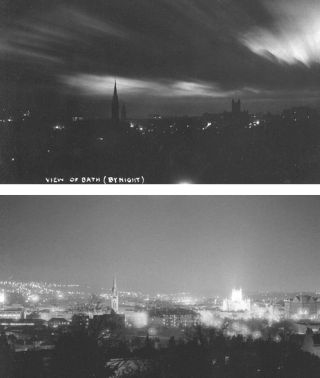

This shows the amount that light pollution has increased over the last 50 years in the city of Bath. Now there seems to be an argument over darker areas and safety, which I can fully understand, but look at the image at the top of the blog, thats the nigh time view of Telford.
What is the need to allow so much light to escape into the night sky? A fine example of how light pollution can be kept to a minimum is the Qatar race circuit, this race track is lit, and suitable for Moto GP racers to use at night, just look at the way the light is diffused just onto the track.

I can see that this is an expensive task to achieve, yet surely there must be someway to pass on this technology to suburbia? Think of your outside lighting, do you just illuminate your garden or the rest of the neighborhood as well, do you really need 500 watts to see?
The following are the aims of the campaign for dark-skies;
CfDS wants to to see:
- Greater use of modern fittings which control the light emitted, to minimise sky-glow and light trespass.
- The right amount of light for the task, not wasteful over-lighting - Sensible wattages (a 40W light will adequately illuminate the average driveway and garden) up to a maximum of 150W;
- Controls on floodlighting of buildings, sports facilities, etc., with appropriate shielding, baffles and mounting adaptation causing lamps to shine preferentially downwards;
- Instructions about sensitive mounting, and information about light trespass and other possible adverse effects, in packaging of all exterior lights.
CfDS believes that:
- Astronomers have the same lighting needs as everyone else;
- Street lights should NOT be turned off, but well directed to illuminate just the street;
- Everyone should have the right to illuminate their premises at night if they so wish, as long as it does not intrude into neighbouring properties;
- Lamps used should comply with Institution of Lighting Engineers' guidelines (revised 1994), with 150W as a maximum value for typical domestic and small-scale commercial premises;
- In the absence of proper regulation of light, which is as much of a potential pollutant as noise and other impactors, retailers should take the lead in preserving a night-time environment showing a balance between good quality lighting and enjoyment of that night-time environment;
- The promotion of outdoor lighting should concentrate on aspects of visibility and careful lighting, rather than making debatable claims about crime deterrence and links between brightness and effectiveness;
CfDS points out that:
- Minimising light pollution saves precious energy resources. The amount of greenhouse gases released into the environment by power stations can be reduced.
- Well designed light sources emit little or no light above the horizontal. Unshielded lights may, depending on the design, emit well over 50% of their output above the horizontal.
- Glare from roadside lights, as motorists know too well, is another result of poor design, and is distracting when driving.





No comments:
Post a Comment